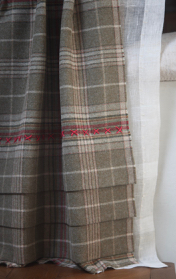String twisted filament, a word interchangeable with twine, but perhaps not always as tight and as strong as we expect twine to be.
We sometimes use coloured strings as embroidery thread for a high level of contrast or with the more open weave rustic woven textiles.
Hand twisted red string adds definition and detail that would have been lost with a finer thread.
Our definition for twine:
A strong thread, light string or cord of twisted strands; the twisting makes each of them stronger. Three are then twisted together in the opposite direction – plied, which creates an extremely strong material, virtually unbreakable.
Synthetic fibres are used but the torsional strength, the grab and longevity of natural fibres is undisputed. Wool, cotton, sisal, jute, hemp, coir and henequen ( Mexican Agave ) have and are being used to make twine. In the past any length of bast fibre, hair, horsehair, any material that could be twisted together in any strength.
Twine and textile material is biodegradable which leaves very little record of the role played by twine, but since we know it existed we must assume that it was imaginatively engineered for whatever purpose it might be needed for. The discovery of ancient beads and the dating fo sea travel to 60000 year ago suggested that twine may well be much older than the earliest found remnant.
Achaeologists have found pieces of twine at Lascaux, France ( 15000 BC), in Georgia’s Dzudzuana Cave, dated to 28000 BC and Israels Ohalo 11 site – 17000 BC. In Peru textile and agave fragments have been dated to 1000b BC. And at Hohle Fels site a tool for twining rope from circa 38000 BC, with evidence of the use of twine in Japan and South America.
The discovery and invention was a highly significant development in civilisation. With twine, objects can oe made, things can be held together, mesh can be made for supporting strictures, for fishing nets, matrreses, and carrying bags. The calibre of the twine found suggests that very fine clothing and household textiles were being made and used much earlier than we have previously understood.
The tools to make twine and to make twine into things were developed into what we now know as spindles, spinning wheels, weaving looms. The very basic weaving loom still being sued to make narrow width Ewe cloth for example is so simple that we can image this who thought to make twine by twisting would also have the mental capacity to weave leaves and any material in an under and over fashion to create mass.
The earliest found quipu, the unique communication device of South America is dated to 3000BC and made of knotted and dyed llama wool and cotton. It seems reasonable to suggest that the earliest item found might not be the first made and used.
The invisible sex; uncovering the true roles of women in pre-history.The fashioning of women. https://archive.org/details/invisiblesexunco00adov/page/178

